fuel tank capacity CITROEN C4 2019 Owners Manual
[x] Cancel search | Manufacturer: CITROEN, Model Year: 2019, Model line: C4, Model: CITROEN C4 2019Pages: 317, PDF Size: 9.31 MB
Page 155 of 317
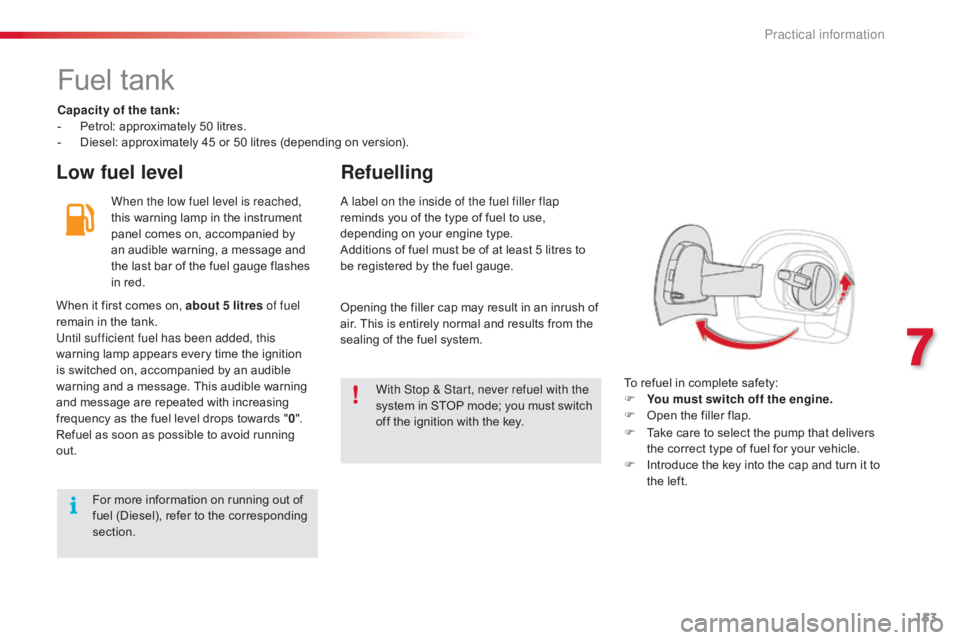
153
C4-cactus_en_Chap07_info-pratiques_ed01-2016
Fuel tank
Capacity of the tank:
- Pe trol: approximately 50 litres.
-
D
iesel: approximately 45 or 50 litres (depending on version).
Low fuel levelRefuelling
When the low fuel level is reached,
this
warning lamp in the instrument
p
anel comes on, accompanied by
a
n audible warning, a message and
t
he last bar of the fuel gauge flashes
i
n red.
To
refuel in complete safety:
F
Y
ou must switch off the engine.
F
O
pen the filler flap.
A label on the inside of the fuel filler flap
reminds
you of the type of fuel to use,
d
epending on your engine type.
Additions
of fuel must be of at least 5 litres to
b
e registered by the fuel gauge.
When
it
first comes on, about 5 litres of fuel
remain
in
the tank.
Until sufficient fuel has been added, this
warning
lamp appears every time the ignition
i
s
switched on, accompanied by an audible
w
arning
and a message. This audible warning
a
nd
message are repeated with increasing
f
requency
as the fuel level drops towards "0 ".
Refuel
as
soon as possible to avoid running
o
ut. Opening
the filler cap may result in an inrush of
a
ir. This is entirely normal and results from the
s
ealing of the fuel system.
With Stop & Start, never refuel with the
system
in STOP mode; you must switch
o
ff the ignition with the key.
For
more information on running out of
f
uel (Diesel), refer to the corresponding
s
ection. F
T
ake care to select the pump that delivers
t
he correct type of fuel for your vehicle.
F
I
ntroduce the key into the cap and turn it to
t
he left.
7
Practical information
Page 177 of 317
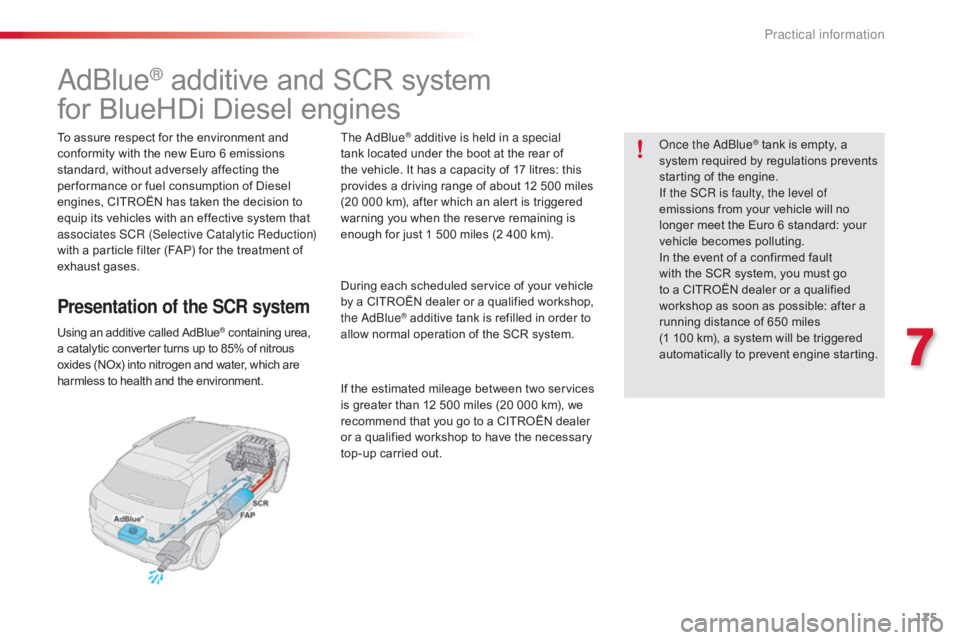
175
C4-cactus_en_Chap07_info-pratiques_ed01-2016
AdBlue® additive and SCR system
f
or
BlueHDi Diesel engines
To assure respect for the environment and c
onformity with the new Euro 6 emissions
s
tandard, without adversely affecting the
p
er formance or fuel consumption of Diesel
e
ngines, CITROËN has taken the decision to
e
quip its vehicles with an effective system that
a
ssociates SCR (Selective Catalytic Reduction)
with
a particle filter (FAP) for the treatment of
e
xhaust gases.
Presentation of the SCR system
Using an additive called AdBlue® containing urea, a
catalytic
converter
turns
up
to
85% of nitrous o
xides
(NOx)
into
nitrogen
and
water, which are
h
armless
to
health
and
the
environment. Once the AdBlue
® tank is empty, a s
ystem
required
by regulations prevents
s
tarting
of
the
engine.
If the SCR is faulty, the level of
emissions
from
your vehicle will no
l
onger
meet
the
Euro 6 standard: your
v
ehicle
becomes
polluting.
In
the
event
of
a
confirmed fault
w
ith
the
SCR
system, you must go
t
o
a
CITROËN
dealer or a qualified
w
orkshop
as
soon as possible: after a
r
unning
distance
of 650 miles
(1
100
km),
a
system will be triggered
a
utomatically
to
prevent engine starting.
The AdBlue® additive is held in a special
tank
located
under the boot at the rear of
t
he
vehicle.
It has a capacity of 17 litres: this
p
rovides
a
driving range of about 12 500 miles
(
20
000
km),
after which an alert is triggered
w
arning
you
when the reserve remaining is
e
nough
for
just 1 500 miles (2 400 km).
During
each
scheduled service of your vehicle
b
y
a
CITROËN dealer or a qualified workshop,
t
he AdBlue
® additive tank is refilled in order to a
llow
normal operation of the SCR system.
If
the
estimated mileage between two services
i
s
greater
than 12 500 miles (20 000 km), we
r
ecommend
that you go to a CITROËN dealer
o
r
a
qualified workshop to have the necessary
t
op-up
carried out.
7
Practical information
Page 181 of 317
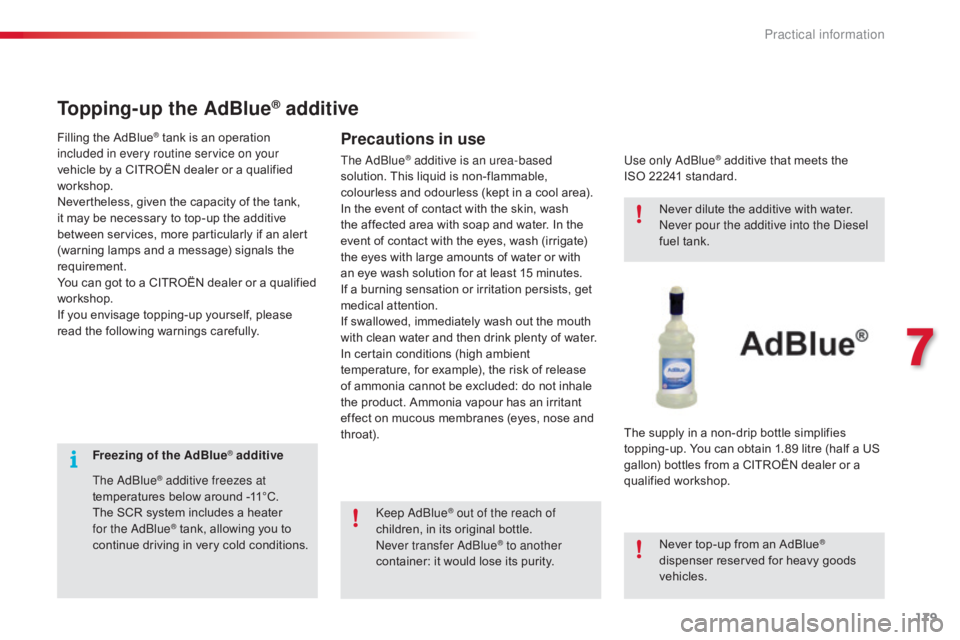
179
C4-cactus_en_Chap07_info-pratiques_ed01-2016
Freezing of the AdBlue® additive
The AdBlue
® additive freezes at
temperatures below around -11°C.
The
SCR
system includes a heater
f
or the AdBlue
® tank, allowing you to c
ontinue
driving in very cold conditions.
Topping-up the AdBlue® additive
Precautions in useFilling the AdBlue® tank is an operation i
ncluded in every routine service on your
vehicle
by
a
CITROËN dealer or a qualified
w
orkshop.
Nevertheless,
given the capacity of the tank,
i
t
may
be
necessary to top-up the additive
b
etween
services,
more particularly if an alert
(
warning
lamps
and a message) signals the
r
equirement.
You
can
got
to
a
CITROËN dealer or a qualified
w
orkshop.
If
you
envisage
topping-up yourself, please
r
ead
the
following
warnings carefully. Keep AdBlue
® out of the reach of
children,
in
its
original bottle.
Never transfer AdBlue
® to another
container:
it
would
lose
its purity. Never
dilute the additive with water.
Never pour the additive into the Diesel
fuel tank.
Never top-up from an AdBlue®
dispenser
reserved
for
heavy
goods
v
ehicles.
Use only AdBlue
® additive that meets the I
SO 22241
standard.
The
supply
in
a
non-drip bottle simplifies
t
opping-up.
You
can obtain 1.89 litre (half a US
g
allon)
bottles
from a CITROËN dealer or a
q
ualified
w
orkshop.
The AdBlue® additive is an urea-based
solution.
This liquid is non-flammable,
c
olourless
and odourless (kept in a cool area).
In
the
event
of contact with the skin, wash
t
he
affected
area with soap and water. In the
e
vent
of
contact with the eyes, wash (irrigate)
t
he
eyes
with large amounts of water or with
a
n
eye
wash
solution for at least 15 minutes.
I
f
a
burning
sensation or irritation persists, get
m
edical
attention.
If
swallowed, immediately wash out the mouth
w
ith
clean
water and then drink plenty of water.
In
certain
conditions (high ambient
t
emperature,
for example), the risk of release
o
f
ammonia
cannot be excluded: do not inhale
t
he
product.
Ammonia vapour has an irritant
e
ffect
on
mucous membranes (eyes, nose and
t
hroat).
7
Practical information
Page 292 of 317
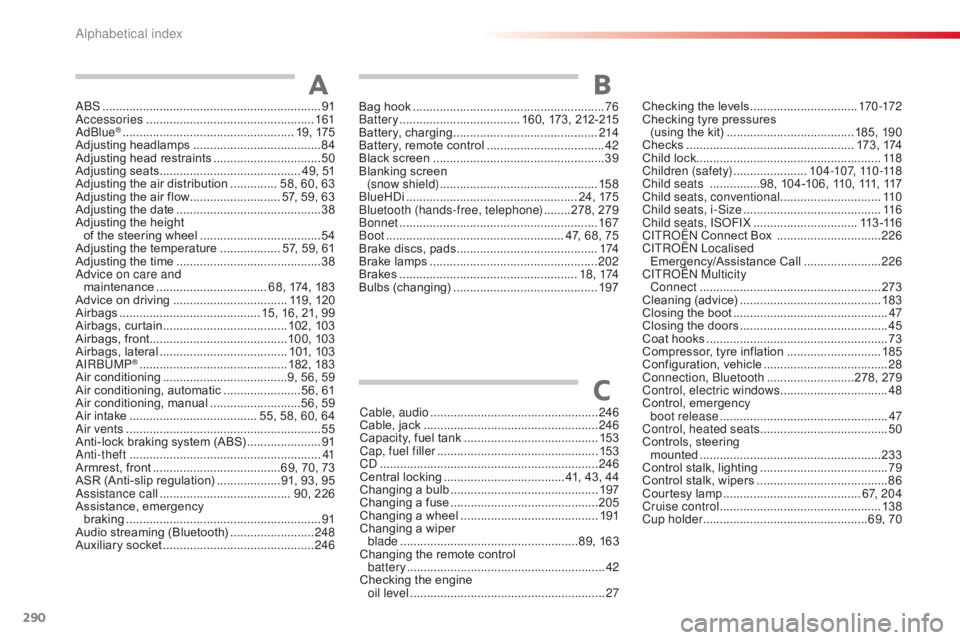
290
C4-cactus_en_Chap11_index-alpha_ed01-2016
ABS .................................................................91
Accessories .............................. ....................161
AdBlue
® ............................... .................... 19, 175
Adjusting h eadlamps ...................................... 84
A
djusting head restraints
................................ 50
A
djusting
s
eats
.......................................... 4
9, 51
Adjusting
the air distribution
.............. 5
8, 60, 63
Adjusting
the air flow
........................... 5
7, 59, 63
Adjusting
the date
........................................... 38
A
djusting the height
of
the
steering wheel
.................................... 54
A
djusting the temperature
.................. 5
7, 59, 61
Adjusting
the time
........................................... 38
A
dvice on care and
maintenance
................................. 6
8, 174, 183
Advice
on driving
..............................
.... 119, 120
Airbags
...............
........................... 15, 16, 21, 99
Airbags,
c
urtain
..................................... 10
2,
10
3
Airbags,
front......................................... 10 0,
10
3
Airbags,
la
teral
...................................... 10
1,
10
3
AIRBUMP
® ............................................ 18 2, 18 3
Air c
onditioning ............................... ......9, 56, 59
Air
conditioning, automatic
.......................5
6, 61
Air
c
onditioning,
m
anual
...........................5
6, 59
Air
intake
...............
....................... 55, 58, 60, 64
Air vents
..............................
............................ 55
Anti-lock
braking system (ABS)
......................91
A
nti-theft
..............................
...........................41
Armrest,
front
......................................6
9, 70, 73
ASR
(Anti-slip regulation)
...................9
1, 93, 95
Assistance call
...............................
........ 90, 226
Assistance,
em
ergency
b
raking
...............
........................................... 91
Audio
streaming (Bluetooth)
.........................24
8
Auxiliary
socket
............................................. 24
6
AChecking the levels ................................17 0 -172
Checking tyre pressures
(using
the kit)
..............................
........185, 190
Checks
...............
................................... 173 ,
17
4
Child
lock
...............................
........................118
Children (safety)
...................... 10
4 -107, 110 -118
Child seats
...............9
8, 104-106, 110, 111, 117
Child seats, conventional
.............................. 11
0
Child seats, i-Size
...............................
..........11 6
Child seats, ISOFIX
...............................11
3 -11 6
C
ITROËN
Connect Box
...............................2
26
C
ITROËN
L
ocalised
Emergency/Assistance
C
all
.......................2
26
CITROËN Multicity Connect
...............
....................................... 273
Cleaning
(
advice)
.......................................... 18
3
Closing
the boot
...............................
...............47
Closing
the doors
...............................
.............45
Coat
hooks
...............................
.......................73
Compressor,
tyre inflation
............................18
5
Configuration,
v
ehicle
..................................... 28
C
onnection, Bluetooth
..........................2
78, 279
Control, electric windows
................................ 48
C
ontrol,
em
ergency
b
oot release
...............................
...................47
Control, heated seats
...................................... 50
C
ontrols, steering
mounted
...................................................... 23
3
Control
stalk, lighting
...................................... 79
C
ontrol stalk, wipers
....................................... 86
C
ourtesy lamp
...............................
..........6 7, 2 0 4
Cruise control
................................................ 13
8
Cup holder
...............................
..................69, 70
Cable, audio
..................................................
24
6
Cable,
jack
..............................
...................... 246
Capacity,
fuel
tank
..............................
.......... 153
Cap, fuel filler
................................................ 15
3
CD
..............................
................................... 246
Central
locking
.................................... 4
1,
43,
44
Changing
a bu
lb
............................................ 19
7
Changing
a f
use
............................................ 20
5
Changing
a
wheel
...............................
.......... 191
Changing
a
wiper
blade
...............
......................................89,
163
Changing
the
remote
control
battery
........................................................... 42
C
hecking
the
engine
oil level
...............
........................................... 27
C
Bag hook ............................... ..........................76
Battery ............................... ..... 160, 173, 212-215
Battery,
c
harging
...............................
............214
Battery,
remote control
...................................42
B
lack screen
..............................
.....................39
Blanking
screen
(snow shield)
...............................
................15 8
BlueHDi
...............................
.................... 24, 175
Bluetooth (hands-free, telephone)
........2
78, 279
Bonnet
...............
............................................ 167
Boot
........
............................................. 47, 68, 75
Brake
discs, pads
...............................
...........174
Brake
lamps
...............................
...................202
Brakes
..................................................... 1
8 , 174
Bulbs
(
changing)
...............................
............197
B
Alphabetical index
Page 309 of 317
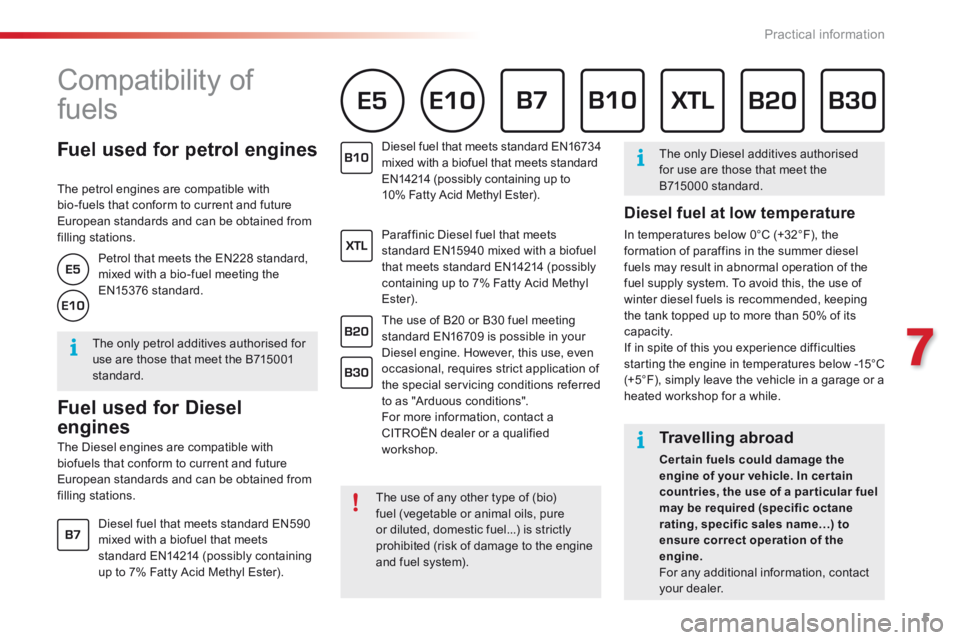
5
7
Practical information
Fuel used for petrol engines
The petrol engines are compatible with bio-fuels that conform to current and future European standards and can be obtained from filling stations.
Fuel used for Diesel
engines
The Diesel engines are compatible with biofuels that conform to current and future European standards and can be obtained from filling stations.
Diesel fuel that meets standard EN590 mixed with a biofuel that meets standard EN14214 (possibly containing up to 7% Fatty Acid Methyl Ester).
Diesel fuel that meets standard EN16734 mixed with a biofuel that meets standard EN14214 (possibly containing up to 10% Fatty Acid Methyl Ester).
Paraffinic Diesel fuel that meets standard EN15940 mixed with a biofuel that meets standard EN14214 (possibly containing up to 7% Fatty Acid Methyl Ester).
The use of B20 or B30 fuel meeting standard EN16709 is possible in your Diesel engine. However, this use, even occasional, requires strict application of the special servicing conditions referred to as "Arduous conditions". For more information, contact a CITROËN dealer or a qualified workshop.
The use of any other type of (bio)fuel (vegetable or animal oils, pure or diluted, domestic fuel...) is strictly prohibited (risk of damage to the engine and fuel system).
The only petrol additives authorised for use are those that meet the B715001 standard.
Travelling abroad
Cer tain fuels could damage the engine of your vehicle. In cer tain countries, the use of a par ticular fuel may be required (specific octane rating, specific sales name…) to ensure correct operation of the engine. For any additional information, contact
your dealer.
The only Diesel additives authorised for use are those that meet the B715000 standard.
Petrol that meets the EN228 standard, mixed with a bio-fuel meeting the EN15376 standard.
Compatibility of
fuels
Diesel fuel at low temperature
In temperatures below 0°C (+32°F), the formation of paraffins in the summer diesel fuels may result in abnormal operation of the fuel supply system. To avoid this, the use of winter diesel fuels is recommended, keeping the tank topped up to more than 50% of its capacity. If in spite of this you experience difficulties starting the engine in temperatures below -15°C (+5°F), simply leave the vehicle in a garage or a heated workshop for a while.